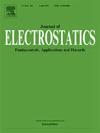研究安装静电系统对果园自动喷雾机性能的影响
IF 2.1
4区 工程技术
Q3 ENGINEERING, ELECTRICAL & ELECTRONIC
引用次数: 0
摘要
尽管人们知道农药的有害影响,但农药和喷雾器的生产和销售在世界范围内仍然是一个不断增长的行业,特别是在亚洲。鉴于目前需要确保不断增长的全球人口的粮食供应和农药使用的必要性,开发创新系统提供了减少农药消耗的实用而快速的解决方案。因此,利用静电喷雾器等农药技术,不仅可以提高农药施用性能,还可以减少农药使用对环境的不良影响。此外,由于静电系统相对简单,可以安装在各种类型的喷雾器上,因此可以在短时间内在农业中进行商业利用。本研究设计并构建了一个静电系统,使农药微粒带电,提高果园自动喷雾机的性能。对该系统的性能进行了评估,并成功地通过静电感应方法对水滴进行了充电,在距离喷雾器喷嘴10厘米的距离上,在流速为1 L / min的情况下,使用20千伏的电压,实现了最大比电荷为1.0毫库仑/千克。此外,在实际果园条件下,考虑农药在树上和地上的沉积以及颗粒漂移,对静电果园自动喷雾器的性能进行了评价。评价涉及对水敏纸进行图像处理,评价农药沉降。静电系统显著地将颗粒漂移减少到零,并且平均而言,12%的水敏纸表面,用于模拟农药沉积在叶子背面,变成了农药装载。本文章由计算机程序翻译,如有差异,请以英文原文为准。

Investigating the effect of installing an electrostatic system on the performance of an orchard automizer sprayer
Despite knowledge of the harmful effects of pesticides, the production and sale of pesticides and sprayers remain a growing industry worldwide, particularly in Asia. Given the current need to ensure food supply for the increasing global population and the necessity of pesticide use, the development of innovative systems presents a practical and rapid solution to reduce pesticide consumption. Therefore, the utilization of pesticide technologies, such as electrostatic sprayers, can not only enhance the performance of pesticide application but also reduce the adverse environmental impacts of pesticide use. Furthermore, since electrostatic systems are relatively simple and can be installed on various types of sprayers, they can be commercially utilized in agriculture within a short timeframe. In this study, an electrostatic system was designed and constructed to charge pesticide particles and improve the performance of orchard automizer sprayers. The performance of this system was assessed, and it successfully charged water droplets through the electrostatic induction method, achieving a maximum specific charge of 1.0 millicoulombs per kilogram at a flow rate of 1 L per minute and a distance of 10 centimeters from the sprayer nozzle, using a voltage of 20 kilovolts. Moreover, the performance of the electrostatic orchard automizer sprayer was evaluated under real orchard conditions, considering pesticide deposition on trees and the ground, as well as particle drift. The assessment involved image processing of water-sensitive paper to evaluate pesticide deposition. The electrostatic system significantly reduced particle drift to zero, and on average, 12 % of the water-sensitive paper surfaces, placed for simulating pesticide deposition on the back of leaves, became pesticide-laden.
求助全文
通过发布文献求助,成功后即可免费获取论文全文。
去求助
来源期刊

Journal of Electrostatics
工程技术-工程:电子与电气
CiteScore
4.00
自引率
11.10%
发文量
81
审稿时长
49 days
期刊介绍:
The Journal of Electrostatics is the leading forum for publishing research findings that advance knowledge in the field of electrostatics. We invite submissions in the following areas:
Electrostatic charge separation processes.
Electrostatic manipulation of particles, droplets, and biological cells.
Electrostatically driven or controlled fluid flow.
Electrostatics in the gas phase.
 求助内容:
求助内容: 应助结果提醒方式:
应助结果提醒方式:


